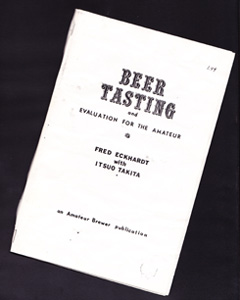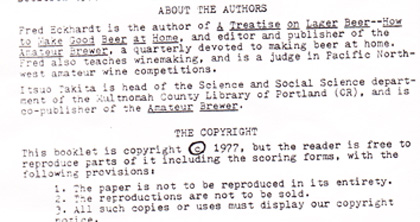 In 1977, the same year Michael Jackson wrote The World Guide to Beer, Fred Eckhardt and Itsuo Takita published a somewhat smaller tome.
In 1977, the same year Michael Jackson wrote The World Guide to Beer, Fred Eckhardt and Itsuo Takita published a somewhat smaller tome.
Beer Tasting and Evaluation for the Amateur wrapped everything up in a modest 16 pages. As you can see, it was printed at a local copy shop. In the preface they wrote their goal was to “get the ball rolling.” The bulk — if such a word is appropriate in something this size — focused on flavor, evaluating that flavor and providing a score (based on a 20-point scale, somewhat different than the one that appeared in Eckhardt’s Essentials of Beer Style in 1989) for each beer.
Quite honestly, I had forgotten I had this. It toppled off the shelf when I reached for Essentials to see how many styles Eckhardt had cataloged in 1989 (38, in fact).
Because the pamphlet also included a list of “bottled beers types and categories” that some might call beer styles, and because styles are certainly the topic of the week, with hopes I’m not violating the copyright . . .

I. PALE OR LIGHT COLORED BEERS
A. Low Alcohol Beers.
B. US-type Pale Beer.
C. Malt Liquors.
D. European Continental type lagers.
E. English type ales.
F. European top fermented beers, except class R.
G. Amateur pale malt extract beers.
H. Amateur pale beers, 50% or more grain malts.
II. BROWN OR DARK BEERS
I. U.S. type dark beer.
J. Continental European type dark beers.
K. Strong Ale – celebration ales or beers (over 6% alcohol by weight).
L. Brown Beer.
M. Porter.
N. Stout.
O. Amateur dark malt extract beers.
P. Amateur dark beers, 50% or more grain malts.
III. OTHER BEERS.
J. Still malt beverages.
R. Lactic Acid Beers.
S. Miscellaneous hopped beers.
T. Original rice beers.
U. Other beers not included in the above.
The list totaled three classes, 21 types (4 of them amateur) and 85 categories (examples to follow).
The number of categories in a type varied, as did the detail about each. English type ales (E.) was pretty typical.
E. English type ales. English hop bouquet (Bullion, Fuggle, Golding). Color light straw to dark amber. Pale ale isn’t.
1. English best bitter. Intense, impressive or pronounced ale character, 4.6% /w; 4.8-7.2% /v alcohol. Bass Pale Ale. Whitbread Pale Ale.
2. English Mild Ale. Pronounced, noticeable or mild “ale” character. 3-4% /w; 3.6-4.8% /v alcohol. Rainier Ale.
3. U.S. stock ale. Intense, impressive or pronounced hop and “ale” character, alcohol over 5% /w; 6% /v. Rainier Ale.
4. U.S. mild ale, pronounced, noticeable or mild hop and ale character, 3-4% /w; 3.6-4.8% /v. Color straw to amber. Ballantines Ale.
The authors write, “There are undoubtedly errors in placement of description. We would appreciate correction, and additions.” But it was an interesting first version, saying much about the state of beer in the United States at the time (600 brands available, including 110 imports).
Very interesting! Craft beer history FTW! I’d be curious to see if more of this sort of thing exists in someone’s collection.
I’d like to know about their rating system. I just added one to my blog, but had to kind of make it up
I’ll give you ten bucks for that pamphlet, Stan. And your choice of (1) bottled Oregon beer in any type listed therein.
I’ll make you a copy, Jeff, but my copy stays with me.
You don’t even have to send beer. I’d be asking for a California one – the New Albion Porter, or maybe the Stout.
Hah! Wish I’d known about that pamphlet earlier this year, Stan, because (I’m delighted to say) it backs up my point made here that before Michael Jackson and the World Guide to Beer nobody, anywhere, talked about “beer styles”, only types, varieties and categories, though Fred Eckhardt later proved extremely influential in spreading the expression “beer style” as invented by Michael.
Errr – and if you’re making copies of that pamphlet, I’d love one …
I actually would love a copy. Something for that very tiny niche of beer geeks–the historical records collectors.
I’d like to know about their rating system. I just added one to my blog, but had to kind of make it up
Despite the 20-point scale that one was a little complicated. Fred streamlined it for “The Essentials of Beer Style.” You might prefer that.
1. Prior to Taste, 0-3 (Minimum 1, ordinary beer 2)
2. Odor, 0-4 (Minimum 1, ordinary 2)
3. In-mouth feel, and taste. 0-10, (Minimum 5, ordinary 7)
4. After tasting. Impressive 3, good 2, fair 1, lacking 0.
Seeing how the copyright has expired, would you be able to share this via PDF?
What’s Rainier Ale doing in his list of examples? Was it a different beer in the 70’s and not the Green Death that I encountered in the late 90’s? That was some nasty stuff.
Yes. Rainier Ale was a *very* different brew in the late ’70s and early ’80s; the beer and whisky authority Michael Jackson proclaimed then that, along with Anchor Steam, Rainier Ale was one of the only two American beers worthy of note. But the Rainier Brewing Company was in its death spiral by ’90s, alas, and Pabst or some other giant had bought the “Rainier Ale” name by then, and was slapping the label on high-alcohol plonk.
Mario. I don’t think the copyright has expired. That’s why I didn’t post the whole thing.